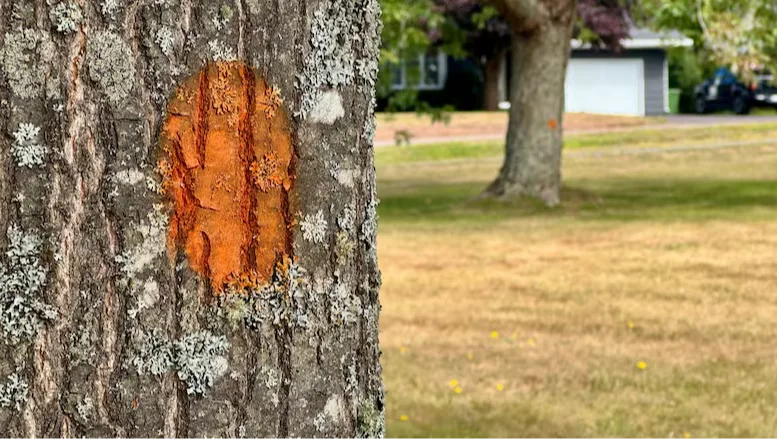
Charlottetown crew clears dangerous trees ahead of next hurricane
Trees across Charlottetown are getting marked with dots and X's, with the city's forest and environmental officer explaining that it's all part of the process of making sure the forest canopy stays safe and lush.
Simon Wilmont said a number of trees are marked to either have deadwood pruned or be cut down entirely as part of the yearly maintenance cycle. Some are starting to decline and others are already dead, presenting a risk either way.
"A lot of the trees will have had damage from (post-tropical storm) Fiona, so that would have caused a rot to penetrate into joints between limbs, or would have caused some structural damage to the main trunk," he said.
"In some of the cases, the roots would have been heaved up a little bit and as a result the trees would not be as safe and secure as they would normally."
RELATED: The best way to prepare for a hurricane is well ahead of a potential disaster
Signs of decline include branches without leaves, leaves that look sparse or stressed, and cracks in the trunks that are widening, exposing the inside of the tree to weather and insect damage.

Simon Wilmont, the forest and environmental officer for the City of Charlottetown, says the city is on track to plant 4,000 trees this year, more than ever before. (Aaron Adetuyi/CBC)
"We have an arborist on the city staff that comes in and does a full risk assessment and looks at the health of the tree and determines what their future [is]," said Wilmont.
He said pruning can help sometimes, but in other cases, it can lead to further issues.
"Sometimes we can prune off a branch and that will alleviate the issue. Sometimes by doing that, we create another problem with the tree," he said.
"The weight might be shifted in a different direction, so at that point we'll look at taking the tree down."
Prepping for future hurricanes
Wilmont said this kind of maintenance is essential to make sure trees stay healthy, especially during the current hurricane season.
"It's always best to get ahead of this kind of work, particularly when we think about things like limbs that we're going to prune off," he said.
"When we use a saw to take a limb off, we can do it cleanly so the tree can recover, whereas a storm is far less surgical in its removal and can rip branches and cause wounds that can become infected with disease or insects."
Centennial Park in Charlottetown alone has had about 10 trees removed this year, Wilmont said — leading to the next part of the job.

Replacing trees that have to be removed from Charlottetown's urban canopy will eventually mean the growth of a new generation of shade producers. (Sarah MacMillan/CBC)
DON'T MISS: The high-stakes factors that decide where a hurricane tracks
"As with all of our parks, we want to put more trees in than we take out... so next spring we'll be coming in here and we'll be replanting trees."
Wilmont said shade trees in particular are very important to the City of Charlottetown.
"The tree canopy is an incredibly important resource for the city, in terms of climate change. The urban forest canopy is one of our greatest resources for adapting," he said.
"Providing that shade reduces the heat-island effect and as a result reduces the temperature for the city as a whole. So wherever we can, we want to increase the canopy and we are aggressively going about that this year."
He said the city is set to plant more trees than ever before with this effort, and are in line to have 4,000 trees planted this year.
This article, originally published by CBC News on August 27, 2025, was written by Ryan McKellop with files from Gwyneth Egan.
Thumbnail credit to Jane Robertson/CBC News